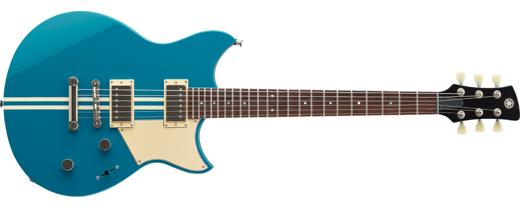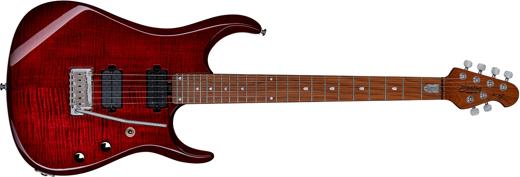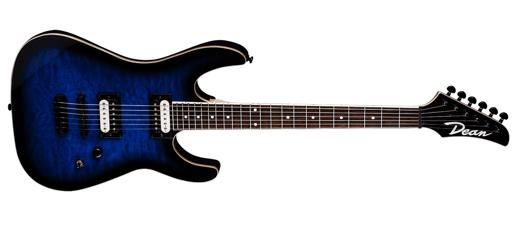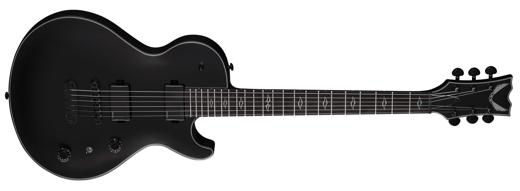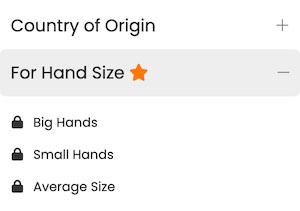Fender Vintera II '60s Bass VI Review & Prices
- From Fender's 2023 Vintera II series
- Made in United States
- 6 strings
- 30"'' scale
- 7.25" Fretboard Radius
- Alder body
- Maple neck
- Slab Rosewood fretboard
- Bridge pickup: Fender Vintage-Style Bass VI Single-Coil (Single Coil/Passive)
- Middle pickup: Fender Vintage-Style Bass VI Single-Coil (Single Coil/Passive)
- Neck pickup: Fender Vintage-Style Bass VI Single-Coil (Single Coil/Passive)
- 1 volume and 1 tone Dome knobs
- 3-way Switch
- 6-Saddle Vintage-Style Adjustable with “Floating” Tremolo Tailpiece bridge
- Bass Mid '60s C Bolt-On neck
- 21 Vintage Tall frets
- Fender Vintage-Style tuners
- Compare Specs >
Our Scores and Tone Evaluation
- Heavy Metal
- Hard Rock
- Jazz
- Blues
- Funk
- Country
Fender Vintera II '60s Bass VI
- Made in United States
- Expensive Wood
- Synthetic Bone Nut
- Top Brand Pickups
- Cheap Fret Wire (NS)
- No Locking Tuners
- No Neck-Through Build
- No Push Knob or Extra Switch Option
- No Weight Relief
- No Luminescent Inlay
- No Active Preamp
- No Compound Radius Fretboard
- No 21:1 Tuner Ratio
- No Retainer Bar
- No Strap Lock
Price Overview
Its average competitor's price is $1400, which means that the Fender Vintera II '60s Bass VI is within the average price asked for this kind of bass. This takes into account all instruments of the same category in our database with 6 strings and Tremolo bridge that are made in United States.
These are affiliate links. We may earn a fee if you purchase after clicking. These prices are prone to error. Make sure you're buying the right product after clicking on a link from our site. We are not liable if you buy the wrong product after following these links. As an Amazon Associate site we earn from qualifying purchases.
Videos










Your feedback
Not all instruments are created equally. That's why it's important to have different opinions. Here's what our users who have played this instrument say. If you've played it before, help others by voting below!
Weight
VoteTuning stability
VoteNeck speed (thickness)
VoteNeck access to high frets
VoteNeck profile shape
VoteFret edges
VotePickups noise
VotePickups power
VoteIs it Easy to Play?
The Fender Vintera II '60s Bass VI meets 5 out of our 6 criteria items for beginner friendliness, which means that it's a good bass to start with as a complete beginner. This takes into account the type of frets, scale length, nut width, bridge type, fretboard radius, and neck profile to determine the easiest combination for new players to get used to.
New Player Friendliness
Fender Vintera II '60s Bass VI- Comfortable shape
- Tall frets
- Narrow nut
- Short scale
- Comfortable neck
- Comfortable fretboard
Hand Size Comfortability
After taking into account the neck profile, scale size, fretboard radius, and nut width, we can conclude that the Fender Vintera II '60s Bass VI's construction favors people with relatively small hands.
Nevertheless, this comes down in the end to personal preference. Make sure you test this bass—or another one with similar characteristics—before buying.
Scale Length
Scale length is the distance the strings will span between the bridge and the nut. It can tell you a lot about the overall playability and tone of the instrument. A longer scale length means longer distance between frets, brighter tone and more string tension—which means lower action, but more difficult bending of the strings.
Here's the Fender Vintera II '60s Bass VI's 30" scale length compared to other common sizes:

This is considered a short scale for a bass. It makes it easier to play for small hands, so if you're just starting or have small hands, it's a good choice to start getting used to the bass.
Neck Profile
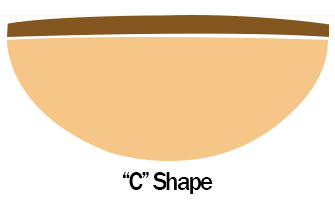
The neck profile tells you the thickness (neck depth) and shape in cross section. Every difference will completely change the feeling and comfortability of the neck. This is a highly subjective thing, but most players indeed prefer certain types of necks (like Cs and Ds) because they feel nice in most hands.
It has a C type neck. C-shaped necks like this have been the most popular for the last years. The reason is that they feel good in most hands. It's generally a thin neck that doesn't get in your way when playing fast, but that also has enough mass to give your hands a comfortable grip for chords if they aren't too big.
Thin necks like this make it easier to move your hand across the neck and it helps when playing fast solos, especially if you like to leave your thumb free while playing high on the fretboard. However, thinner necks are also weaker and will need adjustment more often than a thicker neck.
Fretboard Radius
When it comes to fingerboard radius, personal preference will dictate which one is better for you. However, most people seem to agree that a more curved (lower) radius will make it easier to play chords while a less curved (higher) radius is better for soloing and bending.
The Fender Vintera II '60s Bass VI has a 7.25" fingerboard radius.
Here's an image comparing this fretboard radius to other popular choices:

This type of radius is considered vintage because it's a lot shorter than what is used in modern guitars. It'll make chords easy to play without muting the strings because the curve will give more space for your fingers, and it adapts more naturally to your hand. However, this comes at a disadvantage. Bending the strings will be more difficult because you will have to adapt your bends to the curve. Also, you won't be able to set the action of the strings low because your strings will ''fret out'' and get muted when bending due to the curve making the string hit the other frets.
Compound radius fingerboards give the best of both worlds. Unfortunately, the Fender Vintera II '60s Bass VI has the same radius across the board.
Nut Width
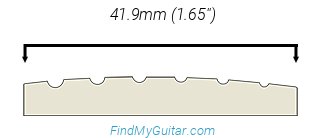
The Fender Vintera II '60s Bass VI has a nut width of 41.9mm (1.65''). This is considered a narrow width for a 6-string bass. A narrow nut width can make it easier for players with smaller hands or shorter fingers to navigate the fretboard comfortably. However, the limited string spacing may pose challenges for slap bass techniques. Additionally, players with larger hands might find a narrow nut width uncomfortable and potentially lead to more accidental muting of neighboring strings.
Frets
The Fender Vintera II '60s Bass VI has 21 frets. Even though 24 frets has become really popular, there's still a good reason to get fewer frets; the pickup at the neck position will be further away from the bridge. This makes the neck pickup achieve a warmer tone. You might want this if you're playing Jazz or similar genres.
However, if you don't care about the warmer neck pickup, more frets will always be better. It's always nice to have the option to play higher notes if you want to.
It comes with nickel silver frets, so they won't last as long as stainless steel frets. If you use your instrument a lot, you might need to replace the frets after a few years. But this is unlikely as most people change instruments before this happens.
Fret Size

Finally, let's talk about fret size. Some people prefer tall frets because it's easier to press the strings and perform bends since there's less friction against the fretboard. On the other hand, some people like shorter frets because they like to touch the fretboard when playing, or because they got heavy hands and tend to press too much on the string and alter the of the note pitch accidently.
The Fender Vintera II '60s Bass VI's frets are Vintage Tall size. This is a confusing name for a fret size because vintage frets are known for being short. However, this size usually means that the crown width is narrower than most modern frets, but the height is a bit taller than the usual vintage fret. You should feel the fretboard when playing with these frets, but they're not as hard to press as real vintage frets.
Playability Score
Tone Analysis
Wood will have little influence in the final tone of an electric guitar or bass. Instead, the hardware, especially the pickups, will be the most important thing to look at. Bur first, let's see the quality of the wood.
Wood



Alder Body: This is a lightweight type of wood that was popularized by Fender. According to them, it's a wood that offers a balanced tone but that favors the upper midrange slightly.
Maple Neck: This is one of the most popular types of wood used in all kinds of guitars. It's heavy, strong and compact, which makes it great for necks. However, it's also used for fretboards, bodies and tops due to its light color, resistance and beautiful patterns. When it comes to tone, it highlights the mid and high frequencies.
Rosewood Fretboard: Since the ban of Brazillian Rosewood, this has become a rare and expensive wood. It's not usually used for guitar bodies because of this, and also because it's heavy. Instead, it's used mainly for fretboards. Sometimes it's also used for necks because it's an extremely hard wood (even harder than maple). Its tonality tends to favor warm tones.
Pickups
This bass comes with pickups from one of the top brands: Fender. So you can expect well built pickups with great sound that shouldn't need an upgrade anytime soon.
These are passive pickups, so you can expect a rounder sound and a moderade level of output.
Preamp
The preamp is an electronic circuit that serves as an intermediary between the bass's pickups and the amplifier. Its primary function is to boost and shape the bass's raw signal before it reaches the amplifier. This allows for greater control over the bass's tone, volume, and other sound characteristics. Preamps often include tone controls, equalization settings, and sometimes even onboard effects, enabling bassists to tailor their sound to their preferences and the musical context.
This bass has a Passive preamp. A bass with a passive preamp lacks an onboard electronic circuit for tone shaping and signal boosting. Instead, it relies solely on passive pickups and basic tone controls, typically consisting of volume and tone knobs. Passive preamps don't require an external power source like batteries, making them low-maintenance and dependable. While they offer a simpler and more straightforward tonal character, passive basses are appreciated for their warm and vintage sound, often favored in genres like classic rock, blues, and funk. They are an excellent choice for musicians who value the simplicity and timeless appeal of their instrument's tone without the need for active electronic components.
The Fender Vintera II '60s Bass VI's configuration is SSS. This is the pickup configuration made famous by the Stratocaster. It gives you beautiful clean tones, but also a vintage-sounding distortion. This pickup combination will sound chimey, but you might be surprised at the warmness that you can get from a single-coil at the neck position on a 22-fret guitar. The disadvantage of this configuration is the hum noise that single-coils produce due to their nature.
Versatility
It comes with the popular 3-way switch that is present in most guitars. For more versatility, players tend to prefer a 5-way switch, although it all depends on what you want to use your bass for.
Unfortunately, it doesn't come with more options for coil split or coil tapping. This makes it less versatile than some competitors.
Diagram
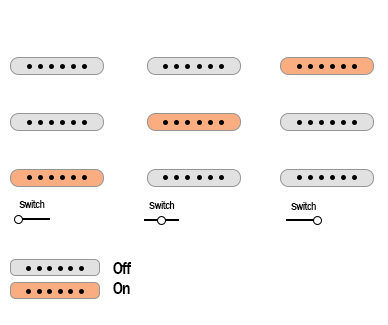
What music genre is it good for?
As a 6 strings, Solid Body bass with SSS configuration and Passive pickups, we'd recommend it for genres like Funk or similar. However, you can use almost any bass for any genre. This is just the typical type of music for this particular one.
Sound Score
Build Quality Analysis
Country of Origin
Knowing where the instrument is produced is a good way to know how well it's built. Some manufacturing countries are known for having higher quality standards. For example, most expensive instruments are made in the US or Japan, but there are some exceptionally great countries—like South Korea—that are building a good reputation.
The Fender Vintera II '60s Bass VI is made in United States. Guitars made in the USA have the reputation of being the best instruments you can get. This statement isn't as accurate as a few years ago, but you should still expect top-quality from a guitar made in this country.
Bridge
6-Saddle Vintage-Style Adjustable with “Floating” Tremolo Tailpiece: This type of bridge allows you to change the pitch of the notes by pulling the bridge with the attached bar, which gives you better versatility. Also, since the bridge is not fixed to the guitar body, the bridge will move as you bend the strings. So you'll have to increase the distance of your bends to reach the same tension (note) compared to a fixed bridge. This allows you to perform smoother bends but will also make you slower. Finally, remember that this type of bridge requires a bit more maintenance than fixed ones, especially when changing strings.
Nut Material
Another important thing to analyze is the nut material, as it's one of the most important aspects that can affect the sound and playability of your bass. A well-cut nut will make sure it stays in tune and will make it more comfortable to play.
In this case, the Fender Vintera II '60s Bass VI has a Synthetic Bone nut. One of the best nuts you can have is a Bone nut thanks to their rich tonality and resistance. The problem is that they're a natural material, so different bone nuts will have inconsistent tonal properties. In other words, one bone nut might not sound as well as the other even when they're made from the same piece. Synthetic bone helps with this by giving you a high-quality, consistent nut that resembles the tone produced by bone.
Neck Joint
The neck joint is the part where the neck of the bass meets the body. There are three main techniques to attach both parts together: Set-In, Bolt-On and Neck-Through. The latter two provide different advantages, although neck-throughs are the most expensive.
This bass has a Bolt-On neck joint. Even though this type of neck was looked down upon for a long time, nowadays bolt-on necks are well built and provide just as much sustain as any other join method. First of all, it's cheap to make because it consists of simply 4 bolts that attach the neck to the body. And you can travel with the guitar more easily, swap out the neck if you damage it, or upgrade to a more comfortable neck later on.
Build Quality Score
All Specs
Fender Vintera II '60s Bass VIUser Reviews
Help others by sharing your opinion about this bass. Note: to avoid spam, your review will be submitted for approval before appearing here.
